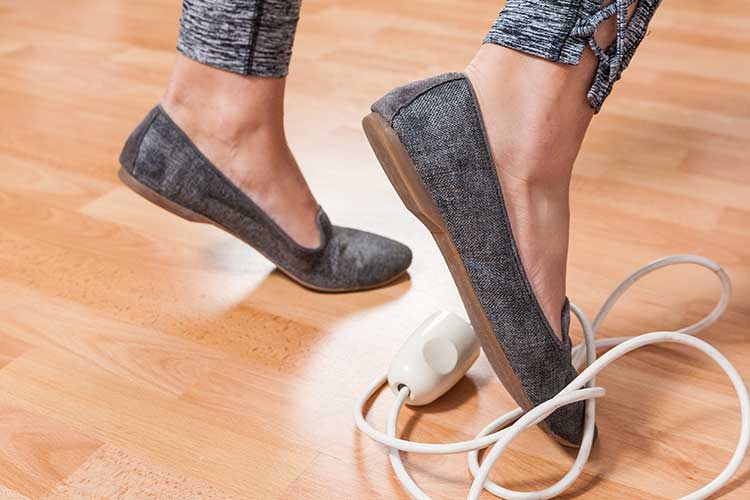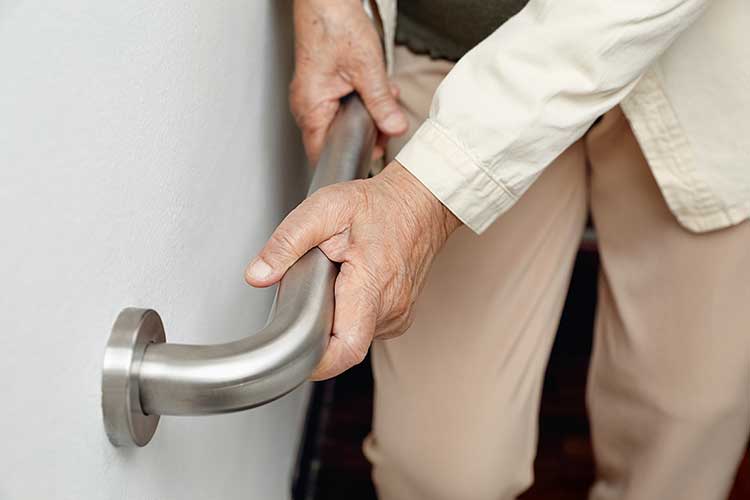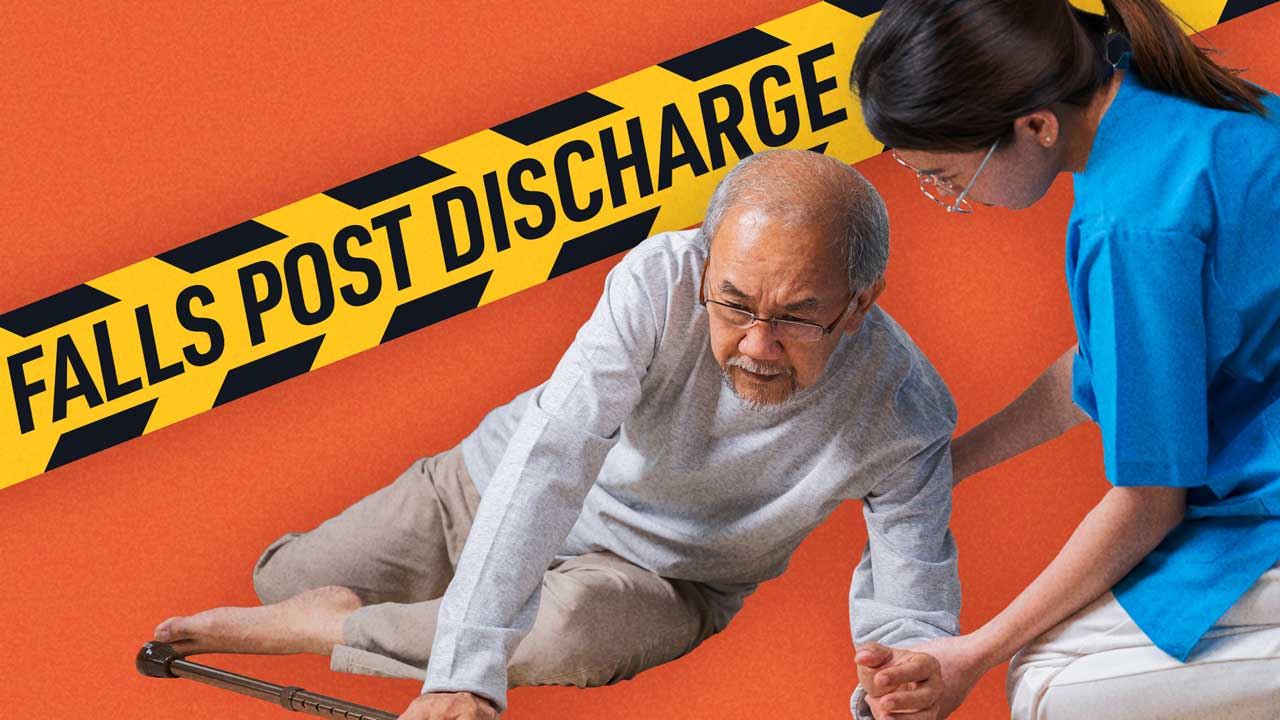Falls in older adults are often serious, resulting in functional decline, reduced quality of life, loss of independence, and in severe cases, even death (Rubenstein 2022).
While about 77% of injury-related hospitalisations among older adults (over 65) are caused by falls (AIHW 2022), hospitalisation is also a major falls risk factor in itself (WA Health 2018).
Falls are among the most common clinical incidents, with the risks only increasing the longer the patient remains in acute care - sometimes even for patients who were not initially at risk of falling (WA Health 2018).
As a result, older people are also at significant risk of falling post-discharge. It is estimated that about 40% of older adults fall within six months of discharge, with 50% of these incidents resulting in injury (Said et al. 2016).
Despite these alarming statistics, most falls are preventable. In order to prevent post-discharge falls and avoid hospital re-admission for falls injuries, it is important for healthcare staff to provide appropriate education to patients and implement falls-prevention strategies as part of discharge planning (Roo et al. 2015).
Also read: Falls Prevention
Why Does Hospitalisation Increase Falls Risk?
Generally, falls occur due to a combination of both intrinsic (personal) and extrinsic (environmental) factors. The more risk factors that are present, the more likely the patient is to fall (Clay et al. 2018). Some common risk factors include:
| Intrinsic risk factors | Extrinsic risk factors |
|
|
(Clay et al. 2018; ACSQHC 2009; Canadian Patient Safety Institute 2015)
Some of these risk factors are static, such as age or baseline health, but hospitalisation may cause additional risk factors to arise or existing risk factors to worsen (Clay et al. 2018). Examples include:
- New or modified medicines or polypharmacy
- Surgery
- Injury
- New cognitive impairment, or exacerbation of an existing cognitive impairment
- Disorientation due to the unfamiliar and complex acute care environment
- Incontinence or constipation
- Changes to mobility or bathroom habits due to unfamiliar acute care environment
- Malnutrition or dehydration
- Mobility aids being misplaced during transit.
(WA Health 2018; Clay et al. 2018)

Preventing Falls After Discharge
Managing falls risk requires a multifactorial approach that addresses the patient’s modifiable risk factors (Clay et al. 2018).
Using an appropriate and validated falls risk assessment tool, identify vulnerable patients and implement appropriate interventions. It’s likely that multiple solutions will need to be implemented in order to target several individual risk factors (Clay et al. 2018).
The Discharge Process
Discharge has been identified as a vulnerable and unsafe stage of the care process due to its complicated and challenging nature (Waring et al. 2014).
Your communication and planning with the client should be clear and comprehensive during discharge. It is important to ensure the patient and their family understand the implementations and strategies that have been discussed. The patient should be encouraged to maintain physical activity and any fear of falling should be addressed, as this can hinder their recovery (Health.vic 2015).
You should also ensure that falls prevention is presented to the patient as a means of staying independent, as this will encourage engagement. It is beneficial to involve the patient in the discussion and decision-making process to ensure interventions meet the patient’s preferences and interests (ACSQHC 2009).
The patient’s general practitioner and other relevant health services should be provided with documentation about the patient’s falls risk and any strategies that have been implemented. You may need to refer the patient to a speciality falls service for ongoing management (Health.vic 2015).
It is also important to ensure the patient is discharged to an appropriate location. While some patients are able to return home following discharge, others may require ongoing care and will need to be transferred to another facility. A comprehensive assessment is required in order to determine the appropriate setting for the patient, taking into account their cognitive status, functional ability, decision-making capacity and other factors (Alper et al. 2023).
Returning Home
It is important to note that upon returning to the community or an aged care facility, patients will have a new baseline risk of falls. This is due to the biological, behavioural, social and environmental changes that may have occurred in response to being hospitalised.
Data from 2010 to 2012 found that 48% of older adult fall hospitalisations in Victoria were for injuries that occurred in the home, while 22% were due to incidents that occurred at residential facilities. These accidents most commonly occurred in outdoor areas, bathrooms, bedrooms and kitchens (Stathakis et al. 2015).
While acute care staff play an important role in addressing falls risk during hospitalisation and discharge, keep in mind that this responsibility is transferred to community healthcare staff and the patient themselves once the patient has returned home or to a residential facility (Hill et al. 2017).

Universal Precautions
The following are some universal precautions that healthcare staff can take to reduce falls risk once patients return to their home or residential facility:
- Ensure effective communication between staff
- Ensure the patient is familiar with their environment
- Ensure the patient knows how to use any call lights or alert devices
- Ensure personal belongings such as glasses are in reach
- Answer call lights as soon as possible so that the patient does not need to ambulate unnecessarily
- Keep the floors clean, dry and free of clutter, and clean any spills as soon as possible
- Use bright lighting and nightlights to increase visibility
- Encourage the patient to wear non-slip footwear
- Keep the patient’s bed at an appropriate height (their feet should be able to touch the floor with their hips, knees and ankles at a 90-degree angle) and lower it while they are resting
- Keep bed and chair breaks on
- Mobilise the patient at least two times per day
- Ensure toileting is safe and regular
- Ensure patients know how to use mobility and assistive devices
- Avoid restrictive practices
- Establish a bowel and bladder function care plan
- Consider frequent vital sign observations
- Ensure patients and staff are properly informed about any medicines, including instructions, dosage and any side effects
- Ensure the patient is not taking unnecessary medicines.
(Performance Health 2019; ACSQHC 2009; Canadian Patient Safety Institute 2015)
Specific Interventions
Depending on their individual risk factors, patients may require specific interventions in addition to universal precautions. Some examples include:
| Modifiable risk factor | Possible Interventions |
| Fear of falling |
|
| Cognitive impairment |
|
| Strength or balance impairment |
|
| Sensory impairment |
|
| Incontinence and toileting issues |
|
| Poor hydration or nutrition |
|
| Medicines |
|
| Environmental hazards |
|
| Disorientation |
|
(Canadian Patient Safety Institute 2015; WA DoH 2023)

Barriers to Post-discharge Falls Prevention
Despite their heightened vulnerability post-discharge, some older adults have been found to lack awareness of their own falls risk or the effectiveness of prevention strategies. Others engage with and acknowledge prevention strategies but encounter unexpected issues such as difficulty taking medicines, pain or poor diet.
Furthermore, while patients often respond positively to tailored education, there is a lack of evidence suggesting that education on its own is enough to reduce post-discharge falls risk (Naseri et al. 2018).
Some other identified barriers include:
- Patients with a high falls risk not receiving a comprehensive risk assessment
- Lack of accurate handover of the patient’s falls risk during discharge
- Failure to assess certain risk factors, preventing the corresponding strategies from being implemented
- Risk-taking behaviour being undertaken by older adults in an effort to maintain independence
- Lack of conversations between patients and community healthcare staff about falls risks.
(Said et al. 2016; Hill et al. 2017)
Conclusion
Falls occur due to an intersection of intrinsic and extrinsic risk factors, many of which develop with age. Hospitalisation is likely to worsen these risk factors and create new ones, compounding the risk further.
Therefore, it is crucial to address and modify these risk factors both during hospitalisation and upon discharge so that the patient does not fall and severely injure themselves after returning to the community.
Test Your Knowledge
Question 1 of 3
Which one of the following is an example of a non-modifiable falls risk factor?
Topics
References
- Alper, E, O’Malley, TA & Greenwald, J 2023, Hospital Discharge and Readmission, UpToDate, viewed 14 August 2023, https://www.uptodate.com/contents/hospital-discharge-and-readmission
- Australian Commission on Safety and Quality in Health Care 2009, Preventing Falls and Harm From Falls in Older People, Australian Government, viewed 11 August 2023, https://www.safetyandquality.gov.au/publications-and-resources/resource-library/preventing-falls-and-harm-falls-older-people-best-practice-guidelines-australian-hospitals
- Australian Institute of Health and Welfare 2022, Falls in Older Australians 2019–20: Hospitalisations and Deaths Among People Aged 65 and Over, Australian Government, viewed 11 August 2023, https://www.aihw.gov.au/reports/injury/falls-in-older-australians-2019-20-hospitalisation/contents/summary
- Canadian Patient Safety Institute 2015, Reducing Falls and Injury from Falls, Canadian Patient Safety Institute, viewed 11 August 2023, https://www.patientsafetyinstitute.ca/en/toolsResources/Documents/Interventions/Reducing%20Falls%20and%20Injury%20from%20Falls/Falls%20Getting%20Started%20Kit.pdf
- Clay, F, Yap, G & Melder, A 2018, Risk Factors for in Hospital Falls: Evidence Review, Monash Health, viewed 14 August 2023, https://monashhealth.org/wp-content/uploads/2019/01/Risk-factors-for-falls_Final-27082018.pdf
- Health.vic 2015, Falls and Discharge Planning, Victoria State Government, viewed 14 August 2023, https://www2.health.vic.gov.au/hospitals-and-health-services/patient-care/older-people/falls-mobility/falls/falls-discharge
- Hill et al. 2017, ‘Reducing Falls After Hospital Discharge: A Protocol for a Randomised Controlled Trial Evaluating an Individualised Multimodal Falls Education Programme for Older Adults’, BMJ Open, vol. 7 no. 2, viewed 14 August 2023, https://www.ncbi.nlm.nih.gov/pmc/articles/PMC5293998/
- Naseri et al. 2018, ‘Impact of Tailored Falls Prevention Education for Older Adults at Hospital Discharge on Engagement in Falls Prevention Strategies Postdischarge: Protocol for a Process Evaluation’, BMJ Open, vol. 8 no. 4, viewed 14 August 2023, https://www.ncbi.nlm.nih.gov/pmc/articles/PMC5914781/
- Performance Health 2019, The Role of Nurses in Fall Prevention, Performance Health, viewed 14 August 2023, https://www.performancehealth.com/articles/the-role-of-nurses-in-fall-prevention
- Roo, SV, Johnston, T & Petersen, L 2015, Readmission Rates for Fall-related Injuries, Queensland Government, viewed 11 August 2023, https://www.health.qld.gov.au/__data/assets/pdf_file/0026/144782/statbite63.pdf
- Rubenstein, LZ 2022, Falls in Older People, MSD Manual, viewed 11 August 2023, https://www.msdmanuals.com/professional/geriatrics/falls-in-older-people/falls-in-older-people
- Said, CM, Batchelor, F, Shaw, K & Blennerhassett, J 2016, ‘Preparing Patients at High Risk of Falls for Discharge Home After Rehabilitation: Do we Meet the Guidelines?’, Geriatr Gerontol Int., vol. 16, no. 5, viewed 11 August 2023, https://ahro.austin.org.au/austinjspui/bitstream/1/13770/1/Said%202016.pdf
- Stathakis, V, Gray, S & Berecki-Gisolf, J 2015, ‘Fall-related Injury Profile for Victorians Aged 65 Years and Older’, Hazard, viewed 14 August 2023, https://www.monash.edu/__data/assets/pdf_file/0003/455961/Monash-Uni-Hazard-Issue-80-summer.pdf
- Waring J, Marshall F, Bishop S, et al. 2014, 'An Ethnographic Study of Knowledge Sharing Across the Boundaries Between Care Processes, Services and Organisations: the Contributions to ‘Safe’ Hospital Discharge', NIHR Journals Library, viewed 14 August 2023, https://www.ncbi.nlm.nih.gov/books/NBK259995/
- WA Health 2014, Inpatient Falls Prevention, Government of Western Australia, viewed 11 August 2023, https://ww2.health.wa.gov.au/Articles/F_I/Inpatient-falls-prevention
- Western Australia Department of Health 2023, Post Fall Multidisciplinary Management Guidelines for Western Australian Health Care Settings 2023, Government of Western Australia, viewed 14 August 2023, https://www.osrecruitment.health.wa.gov.au/-/media/Files/Corporate/general-documents/Health-Networks/Falls-prevention/WA-Post-Fall-Guidelines_Final_2018_PDF.pdf
 New
New 
